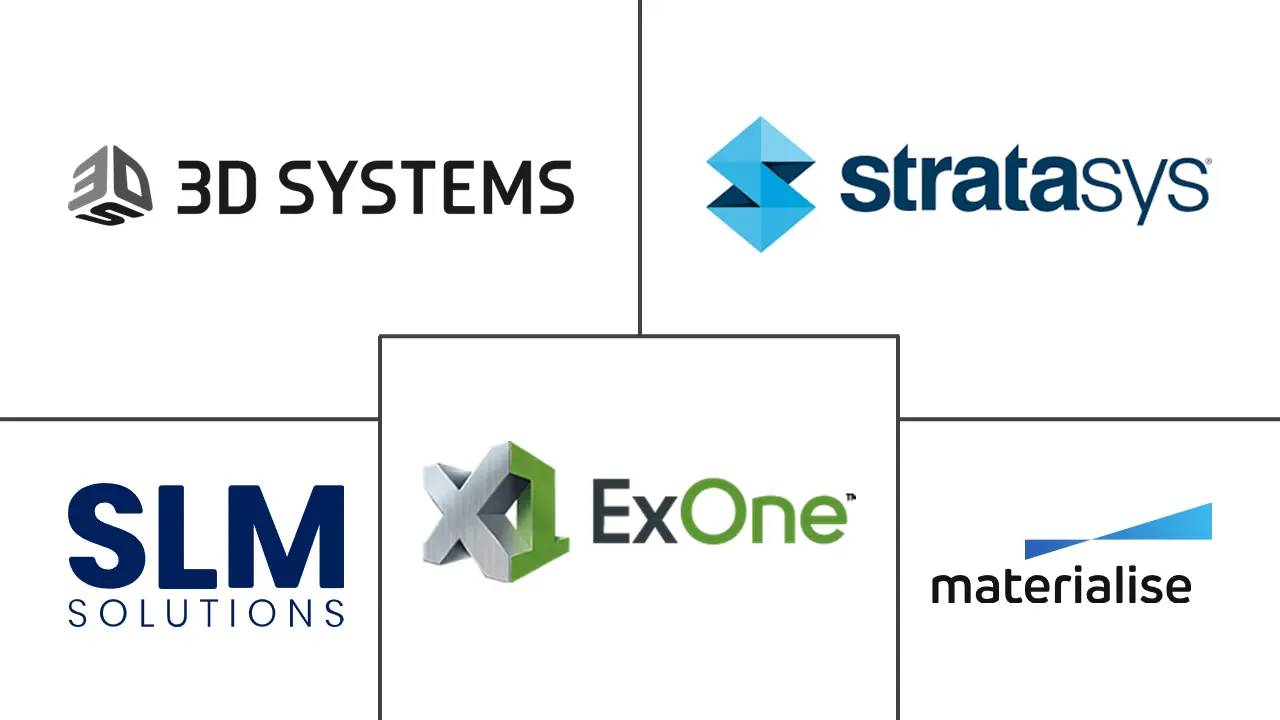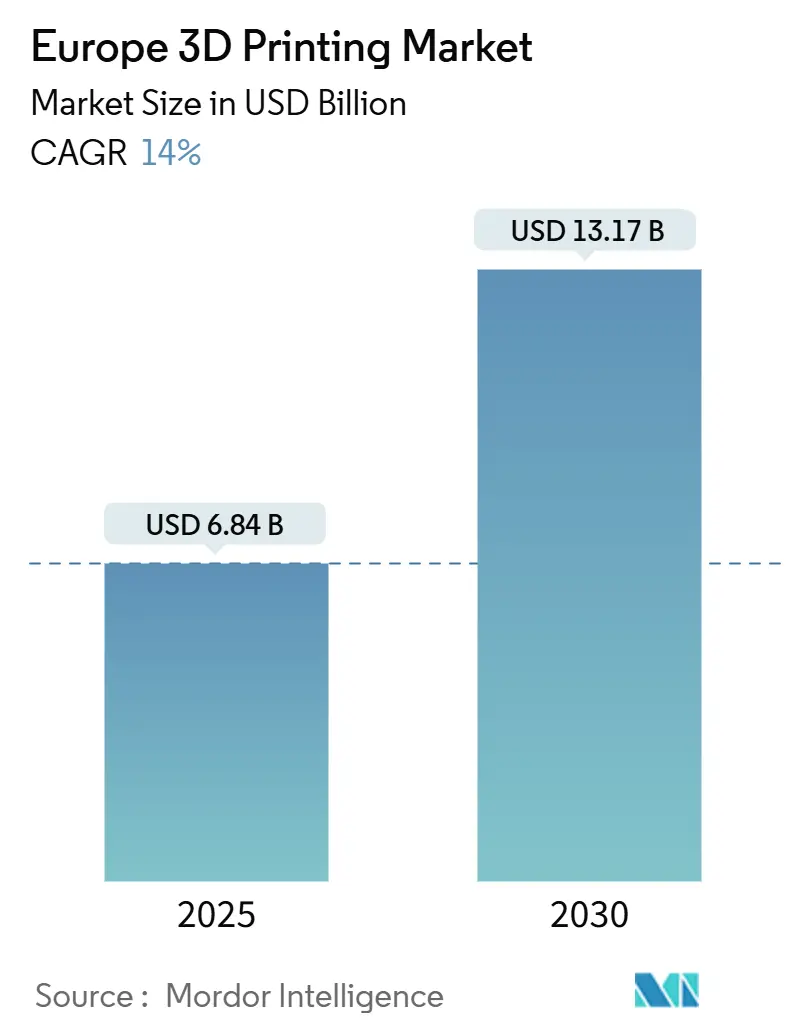
Europe 3D Printing Market Analysis by Mordor Intelligence
The Europe 3D printing market size reached USD 6.84 billion in 2025 and is forecast to climb to USD 13.17 billion by 2030, translating into a 14.00% CAGR during the period. This expansion occurs as manufacturers across the region accelerate distributed-production strategies to cut lead times, hedge against supply-chain shocks and meet carbon-border adjustment requirements that reward localized output. Fast innovation cycles, falling metal-printer costs and the integration of artificial-intelligence process control underpin a widening set of production-grade use cases across automotive, healthcare and maritime industries. Hardware sales still dominate revenue, yet service-oriented “manufacturing as a service” models are scaling quickly, reflecting user preference for flexible capacity without large capital outlays. Country-level momentum is uneven: Germany leverages patent depth and automation expertise to safeguard its leadership position, while the Netherlands deploys world-class logistics and maritime clusters to register the highest growth pace. Competitive intensity rises as incumbents integrate vertically, newer entrants push novel materials and the European Union harmonizes technical standards to ease cross-border operations.
Key Report Takeaways
- By component, hardware captured 68.34% of the Europe 3D printing market share in 2024, while services recorded the fastest CAGR at 16.23% through 2030.
- By technology, FDM led with 29.56% revenue share of the Europe 3D printing market in 2024; DLP is projected to expand at 14.67% CAGR between 2025 and 2030.
- By material, polymers accounted for 54.67% of the Europe 3D printing market size in 2024 and metals and alloys are advancing at a 15.54% CAGR to 2030.
- By end-user industry, automotive held a 24.56% share of the Europe 3D printing market size in 2024, whereas healthcare is moving at a 14.89% CAGR through 2030.
- By country, Germany commanded 29.89% of the Europe 3D printing market share in 2024, and the Netherlands posts the highest projected CAGR at 15.23% to 2030.
Europe 3D Printing Market Trends and Insights
Drivers Impact Analysis
| Driver | (~) % Impact on CAGR Forecast | Geographic Relevance | Impact Timeline |
|---|---|---|---|
| Government initiatives and funding for Industry 4.0 and AM | +2.1% | EU-wide (Germany, France) | Medium term (2-4 years) |
| Automotive OEM demand for lightweight prototyping and tooling | +1.8% | Germany, Italy, France | Short term (≤ 2 years) |
| Healthcare adoption for patient-specific devices | +2.3% | EU-wide (Netherlands, Germany) | Long term (≥ 4 years) |
| Declining cost of metal printers and materials | +1.9% | Industrial regions across EU | Medium term (2-4 years) |
| EU carbon-border adjustment boosting localized production | +1.4% | EU manufacturing hubs | Long term (≥ 4 years) |
| On-demand spare-parts needs in rail and maritime sectors | +1.2% | Netherlands, Germany, Nordics | Medium term (2-4 years) |
| Source: Mordor Intelligence | |||
Government Initiatives and Funding for Industry 4.0 and AM
European governments deploy sizeable capital to speed additive-manufacturing adoption. France’s EUR 54 billion “France 2030” program earmarks funds for advanced manufacturing platforms. Horizon Europe further backs “manufacturing as a service” pilots that network equipment across borders into cloud-managed production lines.[1]Élisabeth Borne, “Understanding France 2030,” info.gouv.fr In Germany, additive-manufacturing firms invest 30.6% of turnover in research, amplified by national and EU grants, cementing leadership in metal systems. The shared funding model drives technology transfer from laboratories to shop floors and builds a cadre of suppliers aligned to common technical standards. As a result, the Europe 3D printing market secures economies of scale that lower entry barriers for mid-sized enterprises.
Automotive OEM Demand for Lightweight Prototyping and Tooling
Automotive manufacturers now pursue additive-manufacturing beyond early prototyping. The EU-funded Multi-FUN project reveals multi-material builds that embed wiring and sensors into lightweight structures.[2]European Commission, “Horizon Europe Multi-FUN Project,” europa.eu German suppliers print low-volume production tooling to manage model-specific parts without storing costly inventory. By exploiting single-build assemblies that cut welds and bolts, companies save weight and shorten production cycles, sustaining momentum for the Europe 3D printing market in core automotive corridors.
Healthcare Adoption for Patient-Specific Devices
Hospitals across Europe scale 3D-printed guides, prosthetics and implants to deliver point-of-care solutions. The European Medicines Agency clarifies approval pathways, giving clinicians confidence to adopt patient-matched devices. EU research consortia such as ENLIGHT explore 3D-printed pancreas prototypes, while PRISM-LT develops living-tissue constructs that could redefine transplant workflows. With reimbursement frameworks catching up, healthcare systems deepen reliance on additive-manufacturing labs, supporting double-digit expansion within the Europe 3D printing market to 2030.
Declining Cost of Metal Printers and Materials
Per-unit metal-printing costs fall as powder recycling techniques—sieving, plasma spheroidization and vacuum degassing—recover feedstock quality for repeated cycles. Equipment makers like EOS bake artificial-intelligence fault prediction into machines to reduce scrap and reprint rates. Higher deposition speeds from electron-beam and selective-laser systems allow mid-volume runs that were once uneconomic, enlarging the reachable addressable base for the Europe 3D printing market.
Restraints Impact Analysis
| Restraints | (~) % Impact on CAGR Forecast | Geographic Relevance | Impact Timeline |
|---|---|---|---|
| High capital investment and maintenance costs | -1.6% | EU-wide, particularly SMEs | Short term (≤ 2 years) |
| Shortage of design-for-AM talent | -1.3% | Industrial regions across EU | Long term (≥ 4 years) |
| Fragmented EU certification and standards landscape | -1.1% | EU-wide, concentrated in medical applications | Medium term (2-4 years) |
| Metal-powder supply volatility and recycling hurdles | -0.9% | Germany, Netherlands, industrial hubs | Medium term (2-4 years) |
| Source: Mordor Intelligence | |||
High Capital Investment and Maintenance Costs
Industrial-grade printers carry six-figure price tags, and users must add powder-handling, post-processing, and quality-assurance gear. Small and medium-sized enterprises often defer purchases even as hardware prices decline. Compliance with the EU Medical Device Regulation imposes rigorous documentation and post-market surveillance, inflating overhead for healthcare adopters. Fragmented certification regimes for rail, aerospace, and energy sectors multiply testing budgets, narrowing the addressable base of the Europe 3D printing market until rental or service models offset risk.
Shortage of Design-for-AM Talent
Less than one-fifth of global manufacturers employ qualified additive-manufacturing engineers, and European firms reflect similar gaps.[3]Society of Manufacturing Engineers, “Key AM Trends to Watch in 2025,” sme.org University programs scramble to integrate lattice optimization, multi-material simulation and process-control modules into curricula. Without the right skillsets, companies fail to exploit geometry freedom, leading to costly redesign loops and unrealized throughput gains. This talent deficit tempers near-term uptake across the Europe 3D printing market, especially for complex production-run opportunities.
Segment Analysis
By Component: Services Accelerate as Hardware Matures
Service providers captured a growing slice of revenue as enterprises prioritize flexibility. Although hardware still anchored 68.34% of the Europe 3D printing market in 2024, service-oriented models are scaling at 16.23% CAGR as firms outsource design optimization, build preparation and post-processing. Contract manufacturers such as K3D and FKM deploy multi-printer farms, giving customers just-in-time parts without locking capital into machines. This transition lowers the cost of experimentation and spreads risk across diverse client pipelines.
In parallel, hardware vendors bundle software, maintenance, and training subscriptions, blurring lines between equipment sales and recurring services. Cloud dashboards aggregate fleet-wide data, enabling predictive maintenance and consumable replenishment. These integrated offers reinforce adoption, propelling the Europe 3D printing market toward outcome-based procurement norms.
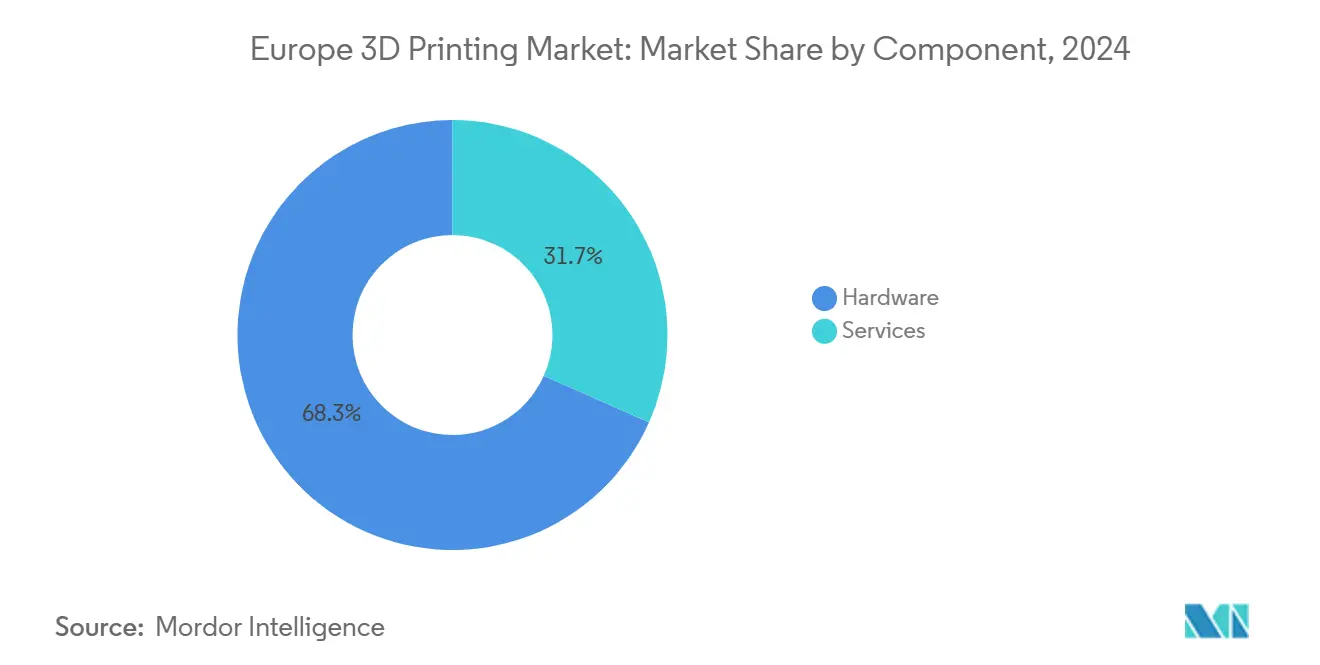
By Technology: DLP Emerges as Precision Manufacturing Leader
FDM maintained the largest share in 2024 at 29.56% thanks to mature materials, low operating costs, and broad user familiarity. Yet DLP is registering an impressive 14.67% CAGR, propelled by sub-50-micron feature capability that suits dental aligners, hearing aids, and tissue-scaffold research. Advances in plant-based photopolymers reinforce sustainability credentials while widening the bio-compatibility palette. SLA and SLS cater to aerospace and automotive requirements for heat-resistant components, whereas electron-beam melting remains the go-to for titanium lattice structures in orthopedic implants.
Technology differentiation now hinges on automation and closed-loop control. AI-driven voxel-level correction trims support mass and eases depowdering, elevating utilization rates across the Europe 3D printing market. Multi-laser coordination in powder-bed systems balances productivity and surface finish, giving manufacturers confidence to qualify parts for serial production.
By Material: Metals Surge Despite Polymer Dominance
Polymers secured 54.67% of revenue in 2024 via versatility in prototyping and tooling. However, metal and alloy volumes are forecast to rise at 15.54% CAGR as post-processing workflows become less labor-intensive and powder reclaim cycles stretch material value. Stainless steel, nickel super-alloys, and aluminum bronze find demand in spare-parts pools for rail, oil-and-gas, and maritime operators seeking corrosion resistance and weight savings.
Sustainability pressures push the development of recycled composites that meet mechanical performance while lowering carbon footprints. Breton’s wood-fiber biocomposites replace virgin polymer feedstock in large-format printers, aligning with circular-economy objectives.[4]Breton S.p.A., “Recycled Biocomposites for 3D Printing,” breton.itCeramics and high-temperature composites carve out niches in energy turbines and chemical reactors, indicating how material breadth underpins the Europe 3D printing market’s future revenue mix.
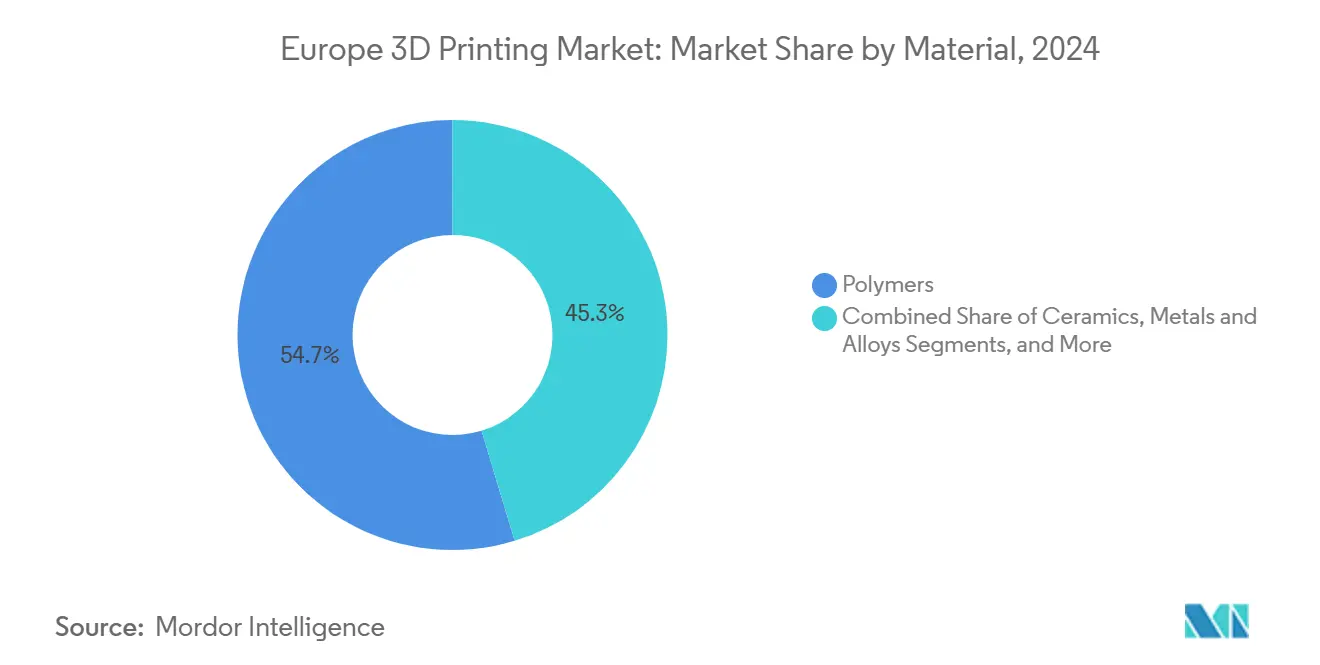
Note: Segment shares of all individual segments available upon report purchase
By End-user Industry: Healthcare Outpaces Traditional Manufacturing
Automotive occupied 24.56% of the Europe 3D printing market in 2024 through applications in wind-tunnel models, lattice seat frames, and on-demand jigs. Yet healthcare posted the sharpest trajectory at 14.89% CAGR as hospitals deploy point-of-care print labs for surgical planning guides and bespoke implants. Aerospace programs qualify weight-critical brackets that consolidate multiple sheet-metal parts into single titanium structures, shaving assembly hours and fuel burn.
Energy utilities incorporate additive manufacturing for burner tips and pump impellers, cutting outage downtime. Construction startups experiment with gantry and robotic systems that extrude cementitious material for façade elements, though building-code harmonization remains a hurdle. Collectively these sectors showcase the broadening demand base sustaining the Europe 3D printing market.
Geography Analysis
Germany retained a commanding 29.89% slice of the Europe 3D printing market in 2024 as its Mittelstand suppliers leverage decades-long automation prowess to commercialize metal-powder bed systems. National and EU grants covering up to 50% of R&D budgets widen the patent moat around firms like EOS and SLM Solutions, while automotive OEMs anchor domestic demand for production tooling. The ecosystem benefits from dense clusters of powder suppliers, measurement-equipment makers and research institutes that streamline part qualification workflows.
The Netherlands advances fastest, clocking a 15.23% CAGR to 2030. Rotterdam’s port infrastructure underpins maritime use-cases such as Royal3D’s large-format printed aquatic drones that reduce mold lead-times for composite hulls. Innovation centers in Eindhoven and Twente channel venture capital into medical and electronics startups, reinforcing a national brand around agile hardware prototyping. Government facilitation of cross-border projects with German shipyards highlights a cooperative model expanding the Europe 3D printing market footprint along the North Sea corridor.
France scales additive manufacturing under the EUR 54 billion France 2030 umbrella, focusing on aerospace propulsion, luxury goods and orthopedic implant value networks. Italy and Spain grow through automotive tooling and multi-jet fusion development hubs, while the United Kingdom preserves momentum via defense and energy programs despite new customs frictions. Eastern European markets, notably Poland, reveal lower adoption owing to moderate capital expenditure appetites; however, EU structural funds and multinational contract work are likely to close the gap, unlocking the next growth frontier for the Europe 3D printing market.
Competitive Landscape
The Europe 3D printing market maintains moderate fragmentation. Incumbents such as Stratasys, EOS and Materialise integrate vertically, offering design software, printers, materials and post-processing kits in unified portfolios. EOS’s partnership with 1000 Kelvin embeds the AMAIZE AI co-pilot into its polymer systems, reducing print failures and engineering hours for aerospace customers. Materialise expands cloud build-preparation services that drive recurring revenue and lock-in across factories with mixed printer brands.
Consolidation intensifies: Nano Dimension agreed to acquire Desktop Metal to combine printed-electronics workflows with metal-binder-jet platforms, while Synopsys’ EUR 35 billion purchase of Ansys signals growing interest from simulation majors in additive-manufacturing physics models. Start-ups address white spaces, Breton scales recycled biocomposites, Catalonian labs optimize plant-derived resins and Meltio partners with K3D to route wire-laser orders around Europe. Companies able to pair sustainability credentials with regulatory compliance stand to gain share as environmental audits feed sourcing decisions throughout the Europe 3D printing market.
Regulation remains a double-edged sword. EU MDR favors corporates with established quality-management frameworks, potentially squeezing smaller medical device service bureaus. Carbon-border rules promote local output yet raise reporting burdens. Businesses that master digital traceability, recording powder batch, energy use and dimensional inspection—demonstrate resilience and earn preferred-supplier status, cementing long-term positions in the Europe 3D printing market.
Europe 3D Printing Industry Leaders
-
Materialise NV
-
SLM Solutions Group AG
-
Stratasys Ltd.
-
3D Systems Corporation
-
ExOne Co.
- *Disclaimer: Major Players sorted in no particular order
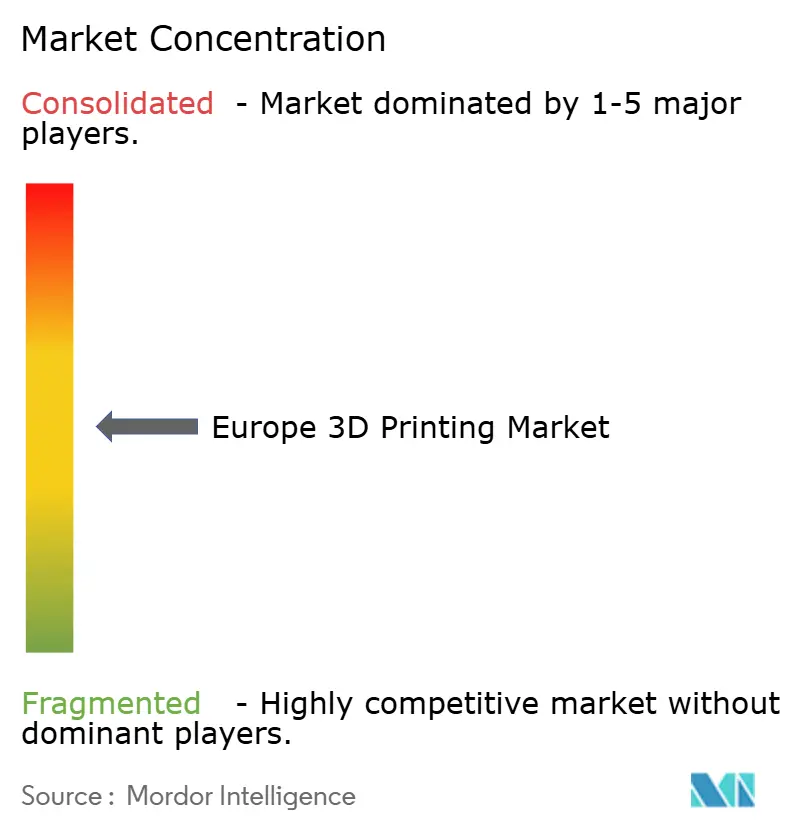
Recent Industry Developments
- May 2025: Catalan researchers debuted plant-based resins compatible with DLP and SLA workflows, enhancing sustainability.
- April 2025: Stratasys previewed Neo800+ stereolithography and PolyJet ToughONE material for aerospace at RAPID + TCT 2025.
- January 2025: Synopsys closed the EUR 35 billion Ansys acquisition after EU clearance, joining simulation and electronics design stacks.
- January 2025: EOS launched the P3 NEXT polymer printer aimed at production-volume applications.
Europe 3D Printing Market Report Scope
3D printing, also known as additive manufacturing, creates a three-dimensional product from a CAD design or a computer 3D model. It can be accomplished using several techniques, whereby a substance is deposited, connected, or solidified beneath computerized control, often layer by layer.
The European 3D printing market is segmented by component (hardware, services), technology (steel lithography (SLA), fused deposition modeling (FDM), electron beam melting, digital light processing, selective laser sintering (SLS), end-user industry (automotive, aerospace, and defense), healthcare, construction and architecture, energy, and food), and country (Germany, the United Kingdom, France, Italy, Spain, the Netherlands, and the rest of Europe).
The market sizes and forecasts are provided in terms of value in USD for all the above segments.
| Hardware |
| Services |
| Stereolithography (SLA) |
| Fused Deposition Modeling (FDM) |
| Selective Laser Sintering (SLS) |
| Electron Beam Melting (EBM) |
| Digital Light Processing (DLP) |
| Other Technologies |
| Polymers |
| Metals and Alloys |
| Ceramics |
| Composites and Others |
| Automotive |
| Aerospace and Defense |
| Healthcare |
| Construction and Architecture |
| Energy and Utilities |
| Food and Beverage |
| Other Industries |
| Germany |
| United Kingdom |
| France |
| Italy |
| Spain |
| Netherlands |
| Rest of Europe |
| By Component | Hardware |
| Services | |
| By Technology | Stereolithography (SLA) |
| Fused Deposition Modeling (FDM) | |
| Selective Laser Sintering (SLS) | |
| Electron Beam Melting (EBM) | |
| Digital Light Processing (DLP) | |
| Other Technologies | |
| By Material | Polymers |
| Metals and Alloys | |
| Ceramics | |
| Composites and Others | |
| By End-user Industry | Automotive |
| Aerospace and Defense | |
| Healthcare | |
| Construction and Architecture | |
| Energy and Utilities | |
| Food and Beverage | |
| Other Industries | |
| By Country | Germany |
| United Kingdom | |
| France | |
| Italy | |
| Spain | |
| Netherlands | |
| Rest of Europe |
Key Questions Answered in the Report
How big is the Europe 3D printing market today?
The market was valued at USD 6.84 billion in 2025 and is forecast to reach USD 13.17 billion by 2030, supported by a 14.00% CAGR.
Which segment is growing fastest within European additive manufacturing?
Services, encompassing design, production outsourcing and post-processing, is expanding at 16.23% CAGR as firms opt for manufacturing-as-a-service over equipment ownership.
Why is the Netherlands outperforming other countries in European 3D-printing adoption?
The Netherlands combines maritime applications, logistics infrastructure and strong innovation funding to post a 15.23% CAGR to 2030.
What materials are gaining share in European additive manufacturing?
Metal powders are the breakout, registering a 15.54% CAGR as costs fall and recycling technologies extend powder life cycles.
How is regulation shaping medical 3D-printing growth in Europe?
Clearer pathways from the European Medicines Agency and the EU Medical Device Regulation support on-site hospital printing while requiring robust quality systems.
Page last updated on:
